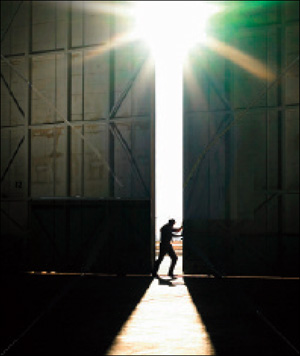In the early days of radio frequency identification, most people believed the technology would be used to take humans out of the loop—that is, fixed readers would capture information on tagged products or assets without any worker involvement. But retailers found that handheld readers offered a relatively easy and inexpensive way to collect inventory data. Now, overhead readers and new robotic systems are offering other ways to collect data. Here are the pros and cons of the three RFID reader options for retailers.
Handheld Readers
Handhelds are relatively inexpensive compared with fixed readers, which require an Ethernet connection and electric power if power is not supplied via the Ethernet cable. That means wiring and potentially interrupting store operations. Depending on reader type and store size, dozens of fixed readers could be required. Store associates could cover the same ground with one or two handhelds.
The downside of handheld readers is they require labor—companies must pay people to walk around and take inventory. Another problem is workers don’t always follow procedures. When a store gets busy, workers may not have time to conduct cycle counts, so items may not be replenished in a timely manner and inventory may not be consistently accurate. In very large stores, it is particularly difficult to manage workers taking inventory with handhelds.
Fixed Overhead and Portal Readers
The first RFID deployments in retail stores depended on fixed readers—mainly, portals were installed at receiving bays, and between the back of the store, where inventory was kept, and the sales floor. In the past few years, Mojix, Impinj and other RFID hardware companies have introduced overhead readers, which can monitor inventory in real time and provide location information, usually to within a few feet. With real-time inventory, retailers can always know what merchandise is on the sales floor and where. In addition, they can use kiosks to let customers search for products and locate those items on a store map.
But, as mentioned above, fixed readers can be expensive to buy and install, because they require cables for Ethernet connections and power. In addition, they need cabling to run to antennas. Fixed readers also can detract from a store’s décor, though some overhead readers can be installed in ceilings and vendors have introduced slim-line antennas that are less obtrusive.
Robotic RFID Systems
Robots are the newest option for retailers seeking to capture inventory data. Tesco announced in June that it is trialing an indoor robotics mapping and analytics system in the fashion departments of five of its U.K. stores. The solution is from Silicon Valley company RFspot, which reports that six other retailers globally are carrying out similar pilots.
The RFspot robots roam through each store’s clothing department. Onboard RFID readers perform inventory counts by reading each garment’s passive ultrahigh-frequency EPC Gen 2 tag, much the way an employee would with a handheld. The RFspot robot is fitted with multiple antenna arrays to enable tags to be read from six inches to 12 feet above the floor. RFspot says the robot is seven times faster than a human using a handheld.
While robots have some clear advantages over store associates when it comes to conducting inventory, they also have some disadvantages. One is cost. Another is having a clunky machine roaming the aisles while people are shopping. Some retailers might prefer to use robots at night, when stores are closed. This would mean updating inventory only after hours or having employees take inventory during working hours. Also, the inventory accuracy of robotic data collection is not yet clear. Tesco and others are aiming to determine more about these factors from the robotics trial.

Retailers deploying RFID systems have been debating which approach will win out. Long-term, RFID Journal believes a fixed RFID infrastructure will likely become an integral part of store systems, hidden from view but constantly monitoring inventory in real time. Lower infrastructure costs, the ability to add readers during renovations or new construction, and improvements in the technology will all contribute to this trend.
But during the next five years, and perhaps much longer, retailers will use handhelds and robotic solutions. Handhelds are a good option for smaller stores, where a single associate can update inventory once or twice a day in less than an hour. The cost of paying a store associate for an hour will likely remain lower than the cost of setting up a fixed infrastructure.
In larger stores, with tens of thousands of tagged items, handhelds will consume too much time and labor to be practical. Retailers will opt for robots or fixed infrastructure, or perhaps a combination of the two. They might use overhead fixed readers to continuously monitor areas of the store that generate the most profit, while using robots to inventory other areas each evening.
The bottom line is that today there is no one right choice for all retailers. Each company should explore all three options and determine which will be most cost-effective, while considering the best long-term data-capture strategy to meet its needs.


